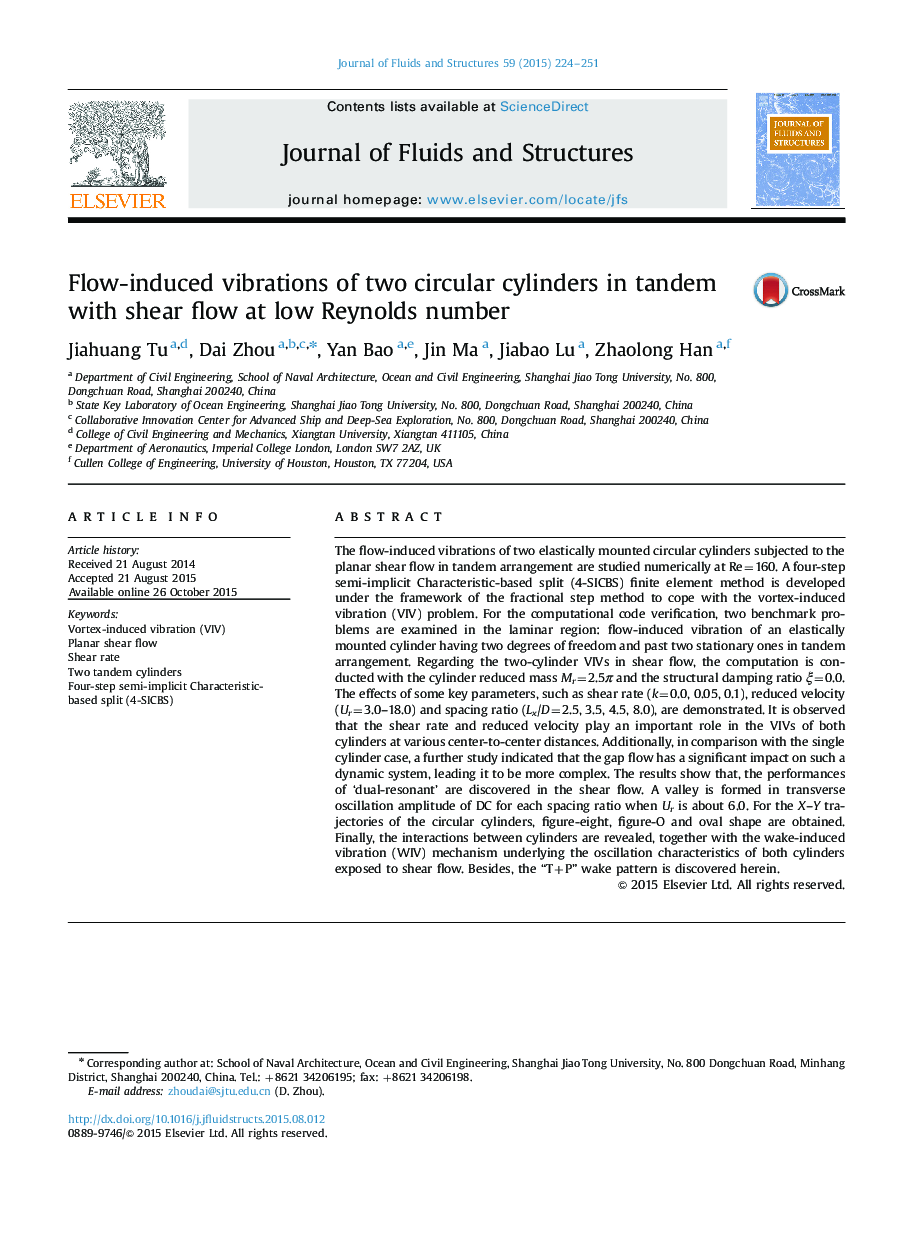| کد مقاله | کد نشریه | سال انتشار | مقاله انگلیسی | نسخه تمام متن |
|---|---|---|---|---|
| 793351 | 1466588 | 2015 | 28 صفحه PDF | دانلود رایگان |
• The VIV of two tandem cylinders in shear flow are numerically investigated at Re=160.
• The dynamic responses of two tandem cylinders in shear flow are investigated.
• The X–Y trajectories of both cylinders subjected to shear flow are investigated.
• The WIV mechanism of both cylinders in planar shear flow is revealed.
The flow-induced vibrations of two elastically mounted circular cylinders subjected to the planar shear flow in tandem arrangement are studied numerically at Re=160. A four-step semi-implicit Characteristic-based split (4-SICBS) finite element method is developed under the framework of the fractional step method to cope with the vortex-induced vibration (VIV) problem. For the computational code verification, two benchmark problems are examined in the laminar region: flow-induced vibration of an elastically mounted cylinder having two degrees of freedom and past two stationary ones in tandem arrangement. Regarding the two-cylinder VIVs in shear flow, the computation is conducted with the cylinder reduced mass Mr=2.5π and the structural damping ratio ξ=0.0. The effects of some key parameters, such as shear rate (k=0.0, 0.05, 0.1), reduced velocity (Ur=3.0–18.0) and spacing ratio (Lx/D=2.5, 3.5, 4.5, 8.0), are demonstrated. It is observed that the shear rate and reduced velocity play an important role in the VIVs of both cylinders at various center-to-center distances. Additionally, in comparison with the single cylinder case, a further study indicated that the gap flow has a significant impact on such a dynamic system, leading it to be more complex. The results show that, the performances of ‘dual-resonant’ are discovered in the shear flow. A valley is formed in transverse oscillation amplitude of DC for each spacing ratio when Ur is about 6.0. For the X–Y trajectories of the circular cylinders, figure-eight, figure-O and oval shape are obtained. Finally, the interactions between cylinders are revealed, together with the wake-induced vibration (WIV) mechanism underlying the oscillation characteristics of both cylinders exposed to shear flow. Besides, the “T+P” wake pattern is discovered herein.
It is worth noting that in this investigation the motion of the downstream cylinder subjected to shear flow is sensitive to the wake of the upstream cylinder. When Lx/D=8.0, the X–Y trajectory of the downstream cylinder is the regular figure-O at Ur=7.0 and k=0.1., it is observed, as shown in Fig. (i), that the downstream cylinder is close to the minimum position in the transverse direction, and the vortex moves towards the downstream at the top of it, avoiding the impacting of the clockwise rotating vortex (marked in blue) on the downstream cylinder oscillation. As shown in Fig. (ii), the counter-clockwise rotating vortex (marked in red) impinges on the downstream cylinder and each one splits into two. On the other hand, the pattern of vortex shedding behind the downstream cylinder resembles T+P mode (T: a triplet of vortices; P: a pair of vortices), as shown in Figs. (iii) and (iv).Figure optionsDownload as PowerPoint slide
Journal: Journal of Fluids and Structures - Volume 59, November 2015, Pages 224–251
